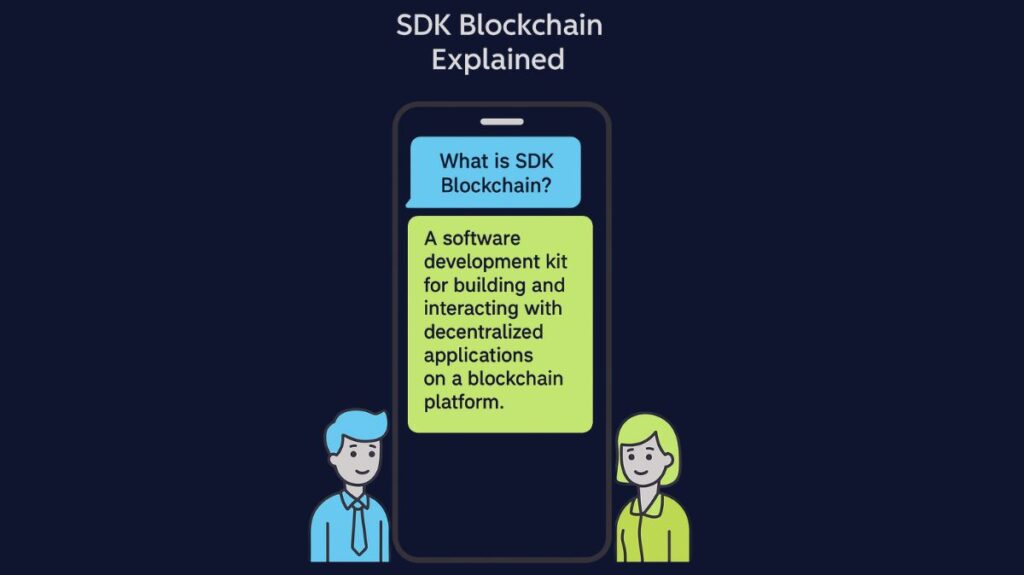SDK Blockchain
Blockchain API Software Development Kits (SDKs) are crucial developer toolkits or libraries that offer a programmatic interface for clients and applications to communicate with blockchain networks. They are essential for creating and improving decentralized apps (DApps).

This is an explanation of how SDKs work within the blockchain ecosystem:
Wrapping API Calls: By effectively wrapping underlying API calls, SDKs streamline the intricate exchanges needed to interface with a blockchain. This abstraction lets developers focus on application logic rather than complex blockchain protocols.
Facilitating Transaction Interaction
- They give apps the means to request, invoke, and propose blockchain transactions.
- Hyperledger Fabric SDKs let clients and apps deploy and execute chaincode (smart contracts), query blocks, and track events.
- In Ethereum, web3.js, which lets web apps access blockchain services, is a popular example. Web3.js provides low-level blockchain data retrieval and transaction submission.
Smart Contract Interaction: For developers to engage with and carry out the business logic included in smart contracts, SDKs are essential. They enable smart contracts to be deployed, run, and respond to. SDKs employ a smart contract’s Application Binary Interface (ABI) to specify its public methods.
Accessing Ledger Data: Applications can access and query the distributed ledger with SDKs. Additionally, they make it easier to keep an eye on and listen for blockchain occurrences.
Supporting Identity Management: SDKs connect with identity services in permissioned networks to manage user identities and grant role-based permissions.
Multi-Language Support: Developers have freedom because blockchain SDKs are frequently available for a number of programming languages, including as Go, Node.js, Java, JavaScript, and Python.
Role in DApp Development: To make blockchain processes accessible to end users, developers employ SDKs to provide user-facing interfaces (such as JavaScript/HTML) that interface with the backend chaincode. SDKs such as web3.js are frequently used by frameworks and tools, like as Ethereum’s Truffle suite, to offer a comprehensive development environment for DApps.
Integration and Modularity: The integration of numerous systems and modules into the larger blockchain ecosystem is made possible via SDKs, which also complement Fabric’s modular and pluggable architecture and enable efficient communication between diverse components. As an illustration, web3.js comprises a number of packages, including web3.eth for smart contract and account interactions, web3.providers for configuring the blockchain client node, and web3.utils for standard utility operations.
Hyperledger Fabric APIs
A strong foundation for enterprise-grade blockchain solutions is offered by Hyperledger Fabric, an open-source private permissioned Distributed Ledger Technology (DLT) architecture created by the Linux Foundation with major assistance from IBM. Fabric does not natively support cryptocurrencies; instead, it is built for business logic, in contrast to public blockchains.
Hyperledger Fabric provides a number of Application Programming Interfaces (APIs) and Command-Line Interfaces (CLIs) to make it easier to communicate with its network. In order for clients and apps to communicate with the underlying ledger and smart contracts, these interfaces are essential.
Hyperledger Fabric APIs are broken down as follows:
Purpose and Functionality
- Interfacing with Fabric: The main way that clients and external applications can connect to the Fabric network is through APIs.
- Enabling Interaction: They enable the proposition, invocation, and querying of blockchain transactions by users and applications.
- Accessing Ledger Services: The distributed ledger is accessed and queried using APIs.
- Smart Contract Interaction: APIs are used by developers to communicate with and carry out the business logic included in smart contracts, also known as chaincode in Hyperledger Fabric. To activate chaincode, change the ledger, and get responses, an application usually establishes a connection with endorsing peers through an SDK, which is a type of API.
- Network and Storage Operations: Functionalities pertaining to network operations and communications with the underlying data storage are likewise covered by the APIs.
- Event Monitoring: They enable apps to keep an ear out for and track blockchain occurrences.
- Identity Management: In order to maintain user identities and grant suitable rights according to roles within the permissioned network, APIs make it easier to communicate with identity services.
Types of Interfaces
- REST APIs: Several REST APIs are directly exposed by Fabric, allowing programmers to create blockchain-interactive apps.
- Command-Line Interfaces (CLIs): For rapid testing and restricted direct blockchain contact, they offer a condensed version of the REST APIs.
- Client SDKs: Applications employ Client SDKs to propose transactions to endorsing peers as part of the consensus process. In essence, these SDKs are developer toolkits that encapsulate the underlying API calls.
Supported Languages for Chaincode Development
Many programming languages, like as Go, Node.js, and Java, as well as Python, can be used to create the smart contracts (chaincode) of Hyperledger Fabric. Because chaincode runs in a sandboxed container environment that supports many languages, multi-language support is made possible.
Role in Decentralized Applications (DApps)
These APIs are used by blockchain developers to create and improve DApps and other blockchain-based apps. A typical Fabric application consists of a user interface (usually written in HTML or JavaScript) that connects to the backend chaincode through an API layer. Through these web apps, end users can communicate with Fabric smart contracts, and they frequently have a clear understanding of the underlying blockchain operations.
Integration and Modularity
The pluggable and modular architecture of Hyperledger Fabric allows consensus engines and smart contracts to be integrated. APIs enable Fabric ecosystem systems and modules to communicate.
